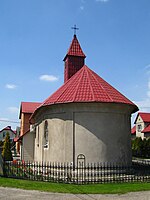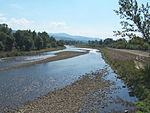Oświęcim Castle

Oświęcim Castle (Polish: Zamek w Oświęcimiu) is a castle raised in the Medieval Ages on the top of a hill, on the right bank of the River Soła in Oświęcim.The castle comprises a thirteenth-century early-Gothic defence tower covered by a roof, a two-floor building built around a courtyard (with the old wing from the beginning of the sixteenth century) and additional connections between the wings built in 1929–31. Most of the fortifications around the castle were destroyed due to the changing river course of the River Soła.On the top of the hill where the castle is located there are remains of the fortifications. There are two tunnels located underneath the castle, the older (built before 1914) and the second which was excavated by the Germans (1940–1944). The tunnels were used as bunkers.
Excerpt from the Wikipedia article Oświęcim Castle (License: CC BY-SA 3.0, Authors, Images).Oświęcim Castle
Długa, gmina Libiąż
Geographical coordinates (GPS) Address Nearby Places Show on map
Geographical coordinates (GPS)
| Latitude | Longitude |
|---|---|
| N 50.057777777778 ° | E 19.296111111111 ° |
Address
Długa 18
32-590 gmina Libiąż
Lesser Poland Voivodeship, Poland
Open on Google Maps







